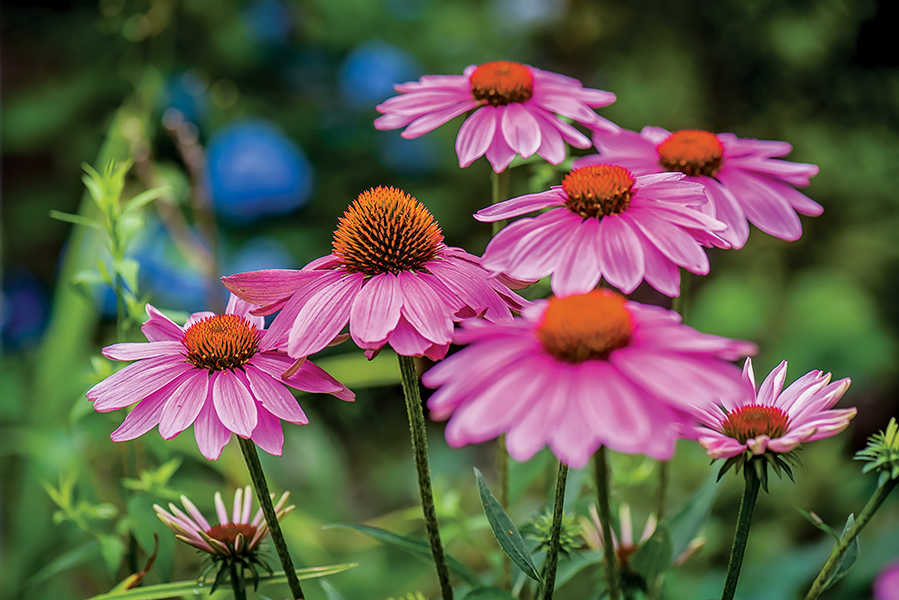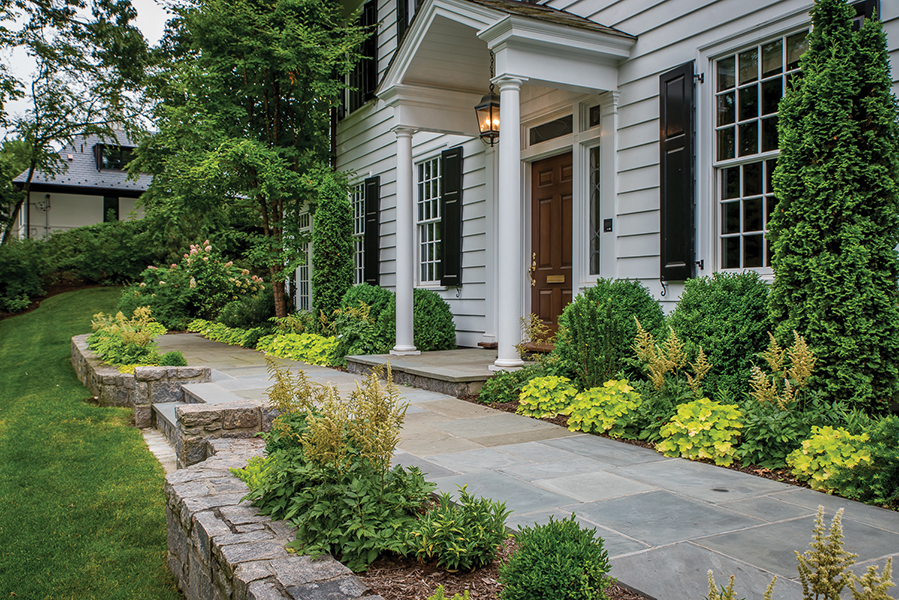Catherine Wachs is clearly busy.
At the end of March, a large calendar on her wall listed landscape design projects that would keep her hands dirty through spring and beyond. Large computer screens in her Larchmont office were loaded with programs to help visualize the layout for bulbous hydrangeas, bright streams of carex and creeping phlox – which her clever website notes rhymes with Wachs.
With snow still in the forecast, she made sure to carve out time for the onslaught of clients who had yet to retire their winter shovels and remember they desperately need her. Outdoor entertaining season would be here soon enough.
Work was certainly piling up for the woman known as The Lazy Gardener.

While “lazy” may not apply to Wachs, when it comes to toiling in the garden, a “high-style, low-maintenance” approach surely resonates with most of us. “People lead busy lives,” she says. “There are about five people a year who want to actually learn how to garden.” For that reason, Wachs uses minimal-fuss plants that don’t require constant work or a full-time gardener. It’s a strategy that works for many of her significant residential and institutional projects and entices homeowners of all stripes.
On her easy-to-navigate website, Wachs offers services that sound quirky but offer real help.
There’s “Organic U,” in which you can pay by the hour to learn how to garden organically. And “Lazy Advice,” with fun articles like the one entitled “No Meatballs: The Art of Proper Pruning.” Her down-to-earth (no pun intended) and playful approach make gardening feel easy.
Wachs’ creative vision was honed during a decades-long career in advertising design, working for industry giants such as global ad agency Young & Rubicam (Y&R). But she began to feel like she was promoting consumerism by day and fighting it by night. A project designing an organic gardening brochure for the League of Women Voters of Westchester began to illuminate a new (dirt) path forward.
“Being connected to plants makes you happy,” she says.
She studied landscape design at the New York Botanical Garden in the Bronx, took a position heading the naturalist educator program at the Sheldrake Environmental Center in Yonkers and “learned the ropes” from her then gardener, Charlie White of White Garden Designs in White Plains, who she still collaborates with for rock and water features.
The concept for The Lazy Gardener started as a local cable television program on Larchmont-Mamaroneck Community Television (LMCTV), in which Wachs gave savvy tips to a Westchester audience. When a neighbor hired her for her first actual project, it meant a budding landscape design career had blossomed. The Lazy Gardener was incorporated in 2007 and has been voted Best of Houzz for service the last five years running.

Courtesy The Lazy Gardener.
The name “Lazy Gardener” also reinforces Wachs’ ethos of working with, not against, nature.
“Let nature do the hard stuff,” she says. Bugs, like spiders and praying mantises, play an important role.
She feels it’s counterproductive to rid a property of leaves to be replaced by mulch. “When leaves are broken down, they infuse ideal nutrients into the soil,” she says. “It costs the town of Larchmont a quarter-million dollars a year to take (them) away…We plant tight to eliminate the need for mulch…One person changing their habits matters.”
When on a job, Wachs and her staff take into account the style and time period of both the building and the neighborhood. For example, a classic Tudor combination would include roses, cat mint and hydrangeas. (Anabelle hydrangeas are native to our area). She determines whether the color palette of the house is cool or warm, takes note of light, the preferences of her clients and the ways they use their space.
“The garden is like the clothes for a house,” she said. “We develop the story line.”
When Wachs is inspired by something new she gives it a test run. “I’ll buy something I’m interested in and try it out in my own garden.”
Classic color pairings in a garden are maroon, blue and gold, though lately some clients have been asking for a strictly white and green garden.
She cautions homeowners to be patient when planting perennials. “They sleep, creep and leap,” she says. They sleep the first year, creep out of the root ball, acclimating to their new environment the second, and leap into full size the third. Take photographs to remember where things are planted.

Wachs feels drip hoses are important to better control the amount of water provided to different plants. “And never till the soil,” she says. “As soon as weeds see light they’ll sprout. They could be waiting 50 years.”
In shady gardens consider ferns, skip laurels, astilbe, carex, leucthoe and Siberian irises.
Good ground covers include moss for shade and elfin thyme for sun. For heavily foot trafficked areas, try stepables like ajuga. And to replace downed trees, “river birch grows super-quick.”
For houses built on steep hills, it’s smart to plant in pockets and consider terrace and rain gardens to capture runoff. Plants that like wet conditions include skip laurels, clethra, liatris and hydrangeas.
Water new grass morning and evening but, once your lawn is established, encourage roots to dig deep by watering once a week. “It’s better to water deeper for longer.” For patchy areas, moss can be a great filler. Wachs suggests blending a clump of it with buttermilk and water to make a slurry, then spread it over soil.
Current trends skew toward contemporary, super-modern design. Black, charcoal and horizontal fencing have been everywhere. No-mow yards are also popular for homeowners who want the look of a lawn with minimal maintenance. Carex, for example, is a grass-like sedge that can keep nontrafficked areas looking vibrant without much tending.
Just remember lavish doesn’t have to equal labor and you can be a lazy gardener, too.
For more, visit lzgardener.com.




